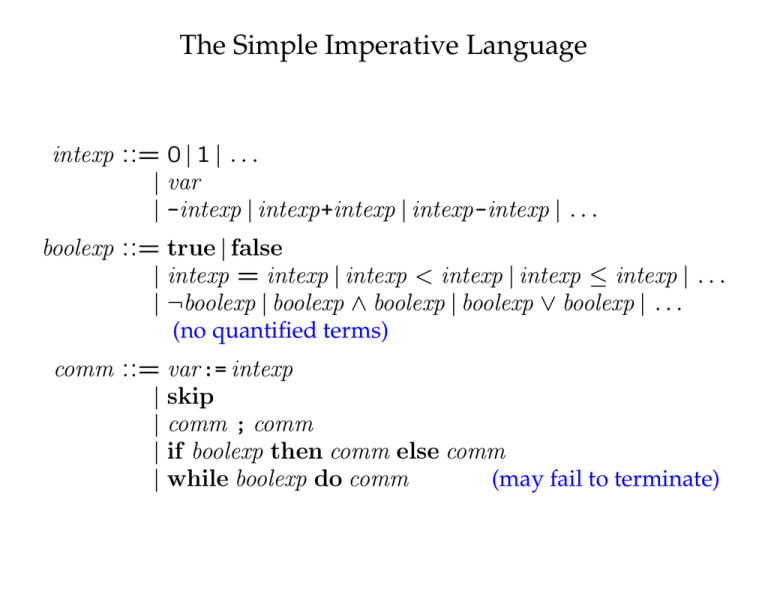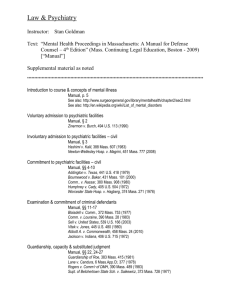The Simple Imperative Language
advertisement

The Simple Imperative Language
intexp ::= 0 | 1 | . . .
| var
| -intexp | intexp +intexp | intexp -intexp | . . .
boolexp ::= true | false
| intexp = intexp | intexp < intexp | intexp ≤ intexp | . . .
| ¬boolexp | boolexp ∧ boolexp | boolexp ∨ boolexp | . . .
(no quantified terms)
comm ::= var := intexp
| skip
| comm ; comm
| if boolexp then comm else comm
| while boolexp do comm
(may fail to terminate)
Denotational Semantics of SIL
[[−]]intexp ∈ intexp → Σ → Z
[[−]]boolexp ∈ boolexp → Σ → B
[[−]]comm ∈ comm → Σ → Σ⊥
[[v:= e]]comm σ
=
Σ = var → Z
(simpler than [[−]]assert )
def
Σ⊥ = Σ ∪ {⊥} (divergence)
[σ | v : [[e]]intexp σ]
[[x:= x*6]]comm [x : 7]
= [x : 7 | x : [[x*6]]intexp [x : 7]]
= [x : 7 | x : 42]
= [x : 42]
[[skip]]comm σ
[[c ;
c0]]
comm σ
=
NOT!
=
σ
[[c0]]comm ([[c]]
σ})
comm
|
{z
= ⊥ if c fails to terminate
Denotational Semantics of SIL
[[−]]intexp ∈ intexp → Σ → Z
[[−]]boolexp ∈ boolexp → Σ → B
[[−]]comm ∈ comm → Σ → Σ⊥
[[v:= e]]comm σ
=
Σ = var → Z
(simpler than [[−]]assert )
def
Σ⊥ = Σ ∪ {⊥} (divergence)
[σ | v : [[e]]intexp σ]
[[x:= x*6]]comm [x : 7]
= [x : 7 | x : [[x*6]]intexp [x : 7]]
= [x : 7 | x : 42]
= [x : 42]
[[skip]]comm σ
[[c ;
c0]]
comm σ
=
NOT!
=
σ
[[c0]]comm ([[c]]
σ})
comm
|
{z
= ⊥ if c fails to terminate
Denotational Semantics of SIL
[[−]]intexp ∈ intexp → Σ → Z
[[−]]boolexp ∈ boolexp → Σ → B
[[−]]comm ∈ comm → Σ → Σ⊥
[[v:= e]]comm σ
=
Σ = var → Z
(simpler than [[−]]assert )
def
Σ⊥ = Σ ∪ {⊥} (divergence)
[σ | v : [[e]]intexp σ]
[[x:= x*6]]comm [x : 7]
= [x : 7 | x : [[x*6]]intexp [x : 7]]
= [x : 7 | x : 42]
= [x : 42]
[[skip]]comm σ
[[c ;
c0]]
comm σ
=
NOT!
=
σ
[[c0]]comm ([[c]]
σ})
comm
|
{z
= ⊥ if c fails to terminate
Denotational Semantics of SIL
[[−]]intexp ∈ intexp → Σ → Z
[[−]]boolexp ∈ boolexp → Σ → B
[[−]]comm ∈ comm → Σ → Σ⊥
[[v:= e]]comm σ
=
Σ = var → Z
(simpler than [[−]]assert )
def
Σ⊥ = Σ ∪ {⊥} (divergence)
[σ | v : [[e]]intexp σ]
[[x:= x*6]]comm [x : 7]
= [x : 7 | x : [[x*6]]intexp [x : 7]]
= [x : 7 | x : 42]
= [x : 42]
[[skip]]comm σ
[[c ;
c0]]
comm σ
=
NOT!
=
σ
[[c0]]comm ([[c]]comm σ)[[c]]
σ}
comm
|
{z
= ⊥ if c fails to terminate
Denotational Semantics of SIL
[[−]]intexp ∈ intexp → Σ → Z
[[−]]boolexp ∈ boolexp → Σ → B
[[−]]comm ∈ comm → Σ → Σ⊥
[[v:= e]]comm σ
=
Σ = var → Z
(simpler than [[−]]assert )
def
Σ⊥ = Σ ∪ {⊥} (divergence)
[σ | v : [[e]]intexp σ]
[[x:= x*6]]comm [x : 7]
= [x : 7 | x : [[x*6]]intexp [x : 7]]
= [x : 7 | x : 42]
= [x : 42]
[[skip]]comm σ
[[c ;
c0]]
comm σ
=
NOT!
=
σ
[[c0]]comm ([[c]]
σ})
comm
|
{z
= ⊥ if c fails to terminate
Semantics of Sequential Composition
We can extend f ∈ S → T⊥ to f⊥⊥ ∈ S⊥ → T⊥:
f⊥⊥ x
def ⊥,
=
f x,
if x = ⊥
otherwise
(−)⊥⊥ ∈ (S → T⊥) → S⊥ → T⊥
(a special case of the Kleisli monadic operator).
This defines
So
[[−]]comm ∈ comm → Σ → Σ⊥
⇒ [[c0]]comm ∈ Σ → Σ⊥
⇒ ([[c0]]comm )⊥⊥ ∈ Σ⊥ → Σ⊥
[[c ; c0]]comm σ = ([[c0]]comm )⊥⊥([[c]]comm σ)
Semantics of Conditionals
[[c0]]comm σ,
if [[b]]boolexp σ = true
[[if b then c0 else c1]]comm σ =
[[c ]]comm σ, if [[b]]
1
boolexp σ = false
Example:
[[if x<0 then x:= -x else skip]]comm [x : −3]
= [[x:= -x]]comm [x : −3],
since [[x<0]]boolexp [x : −3] = true
= [x : −3 | x : [[-x]]intexp [x : −3]]
= [x : 3]
[[if x<0 then x:= -x else skip]]comm [x : 5]
= [[skip]]comm [x : 5],
= [x : 5]
since [[x<0]]boolexp [x : 5] = false
Problems with the Semantics of Loops
Idea: define the meaning of while b do c as that of
if b then (c ; while b do c) else skip
But the equation
[[while b do c]]comm σ
= [[if b then (c ; while b do c) else skip]]comm σ
([[while
=
σ,
b do c]]comm )⊥⊥([[c]]comm σ), if [[b]]boolexp σ = true
otherwise
is not syntax directed and sometimes has infinitely many solutions:
[[while true do x:= x+1]]comm = λσ : Σ. σ 0
is a solution for any σ 0.
Partially Ordered Sets
A relation ρ is reflexive on S
transitive
antisymmetric
symmetric
v is reflexive on P & transitive
iff
iff
iff
iff
∀x ∈ S. xρx
xρy & yρz ⇒ xρz
xρy & yρx ⇒ x = y
xρy ⇒ yρx
⇒v is a preorder on P
v is a preorder on P & antisymmetric ⇒v is a partial order on P
P with a partial order v on P
⇒a poset P
P with IP as a partial order on P
⇒a discretely ordered P
f∈P→P 0 & ∀x, y∈P. (x v y⇒f x v0 f y)⇒f is monotone from P to P 0
y ∈ P : ∀X ⊆ P. ∀x ∈ X. x v y
⇒y is an upper bound of X
Least Upper Bounds
y is a lub of X ⊆ P if y is an upper bound of X
and ∀z ∈ P. (z is an upper bound of X ⇒ y v z)
F
If P is a poset and X ⊆ P , there is at most one lub X of X.
F
{} = ⊥ — the least element of P (when it exists).
Let X ⊆ P P such that
F
X exists for every X ∈ X . Then
G G
{
X |X ∈ X } =
G[
X
if either of these lubs exists. In particular
∞
G
∞
G
xij =
G
{ xij | i ∈ N and j ∈ N } =
i=0 j=0
F
F∞
if ∞
x
exist
for
all
j,
or
i=0 ij
j=0 xij exist for all i.
∞
G
∞
G
j=0 i=0
xij
Domains
A chain is a countably infinite non-decreasing sequence x0 v x1 v . . .
F
The limit of a chain C is its lub C when it exists.
A chain C is interesting if
F
C∈
/ C.
(Chains with finitely many distinct elements are uninteresting.)
A poset P is a predomain (or complete partial order — cpo)
if P contains the limits of all its chains.
A predomain P is a domain (or pointed cpo) if P has a least element ⊥.
In semantic domains, v is an order based on information content:
x v y (x approximates y, y is a refinement of x)
if x yields the same results as y in all contexts when it terminates,
but may diverge in more contexts.
Lifting
Any set S can be viewed as a predomain with discrete partial order
v = IS .
The lifting P⊥ of a predomain P is the domain D = P ∪ {⊥}
where ⊥ ∈
/ P , and x vD y if x = ⊥ or x vP y.
cS[0000
cS[0000
a
d
CK
0000
0000
0000
0000
0000
00 b
JB
e
0000
0000
0000
0000
0000
00
f T\11
1111
1111
1111
1111
1111
1111
g
−→
a ai LLLLLLLLL
b
d
BJ
T\ 22
LLLLL
2222
LLLLLL
2222
LLLLLL
2222
LLLLLL
2222
L
LLLLL
22
L
LLLLL 2222
L
LLLLL 22
BJ
e
f T\11
1111
1111
1111
1111
1111
1111
4<
AI
qq
q
q
qq
qqq
q
q
q
qqq
q
q
q
qqq
qqqq
⊥
D is a flat domain if D − {⊥} is discretely ordered by v.
g
Continuous Functions
If P and P 0 are predomains, f ∈ P → P 0 is a
continuous function from P to P 0 if it maps limits to limits:
G
f ( { xi | xi ∈ C }) =
G0
{ f xi | xi ∈ C } for every chain C ⊆ P
Continuous functions are monotone: consider chains x v y v y . . .
There are non-continuous monotone functions:
Let P ⊇ the interesting chain C = (x0 v x1 v . . .) with a limit x in P ,
and P 0 = {⊥, >} with ⊥ v0 >. Then
f = { [xi, ⊥] | xi ∈ C } ∪ {[x, >]}
is monotone but not continuous:
F0
{ f xi | xi ∈ C } = ⊥ =
6 > = f ( C)
F
Monotone vs Continuous Functions
If f ∈ P → P 0 is monotone, then f is continuous
G
G0
i
i
iff f ( xi) v
(f xi) for all interesting chains xi (i ∈ N) in P .
Proof
[1ex] For uninteresting chains:
if
G
xi = xn, then
G0
i
G
(f xi) = f xn = f ( xi).
i
i
[1ex] For interesting chains: prove the opposite approximation:
(∀i ∈ N. xi v
G
G
xj )⇒ (∀i ∈ N. f xi v f ( xj ))
j
⇒
G0
i
j
G
(f xi) v f ( xi)
i
The (Pre)domain of Continuous Functions
Pointwise ordering on functions in P → P 0 where P 0 is a predomain:
f v→ g ⇐⇒ ∀x ∈ P. f x v0 g x
Proposition:
If both P and P 0 are predomains, then the set [P → P 0] of continuous
functions from P to P 0 with partial order v→ is a predomain with
G
fi = λx ∈ P.
G0
(fix)
If P 0 is a domain, then [P → P 0] is a domain with ⊥→ = λx ∈ P. ⊥0
The (Pre)domain of Continuous Functions: Proof
To prove [P → P 0] is a predomain:
Let fi be a chain in [P →
P 0],
and f = λx ∈ P.
F0
fix.
F0
( fix exists because f0x v0 f1x v0 . . . since f0 v→ f1 v→ . . .
and P 0 is a predomain)
fi v→ f since ∀x ∈ P. fix v0 f x; hence f is an upper bound of {fi}.
If g is such that ∀i ∈ N. fi v→ g, then ∀x ∈ P. fix v0 gx,
hence ∀x ∈ P. f x v0 gx, i.e. f v→ g.
⇒ f is the limit of fi... but is f continuous so it is in [P → P 0]?
Yes: If xj is a chain in P , then
G
G0
j
i
f ( xj ) =
G
G0 G0
j
i j
f i ( xj ) =
f i xj =
G0 G0
j i
f i xj =
G0
j
f xj
Some Continuous Functions
For predomains P, P 0, P 00,
if f ∈ P → P 0 is a constant function, then f ∈ [P → P 0]
IP ∈ [P → P ]
if f ∈ [P → P 0] and g ∈ [P 0 → P 00], then g · f ∈ [P → P 00]
if f ∈ [P → P 0], then (− · f ) ∈ [[P 0 → P 00] → [P → P 00]]
if f ∈ [P 0 → P 00], then (f · −) ∈ [[P → P 0] → [P → P 00]]
Strict Functions and Lifting
If D and D0 are domains, f ∈ D → D0 is strict if f ⊥ = ⊥0.
If P and P 0 are predomains and f ∈ P → P 0, then the strict function
def
f⊥ = λx ∈ P⊥.
f x,
⊥0,
if x ∈ P
if x = ⊥
0 ; if P 0 is a domain, then the strict function
is the lifting of f to P⊥ → P⊥
def
f⊥⊥ = λx ∈ P⊥.
f x,
⊥0,
is the source lifting of f to P⊥ → P 0.
If f is continuous, so are f⊥ and f⊥⊥.
(−)⊥ and (−)⊥⊥ are also continuous.
if x ∈ P
if x = ⊥
Least Fixed-Point
If f ∈ S → S, then x ∈ S is a fixed-point of f if x = f x.
Theorem [Least Fixed-Point of a Continuous Function]
If D is a domain and f ∈ [D → D],
G
def ∞
f i ⊥ is the least fixed-point of f .
then x =
i=0
Proof:
x exists because ⊥ v f ⊥ v . . . f i⊥ v f i+1⊥ v . . . is a chain.
x is a fixed-point because
fx = f(
∞
G
f i⊥) =
i=0
∞
G
i=0
f (f i⊥) =
∞
G
f i⊥ =
i=1
∞
G
f i⊥ = x
i=0
For any fixed-point y of f , ⊥ v y ⇒ f ⊥ v f y = y,
by induction ∀i ∈
N. f i⊥
v y, therefore x = (f i⊥) v y.
F
The Least Fixed-Point Operator
Let
YD = λf ∈ [D → D].
∞
G
f i⊥
i=0
Then for each f ∈ [D → D], YD f is the least fixed-point of f .
YD ∈ [[D → D] → D]
Semantics of Loops
The semantic equation
[[while b do c]]comm σ
([[while
=
σ,
b do c]]comm )⊥⊥([[c]]comm σ), if [[b]]boolexp σ = true
otherwise
implies that [[while b do c]]comm is a fixed-point of
f
def
⊥
⊥([[c]]comm σ),
F = λf ∈ [Σ → Σ⊥].λσ ∈ Σ.
σ,
if [[b]]boolexp σ = true
otherwise
We pick the least fixed-point:
def
[[while b do c]]comm = Y[Σ→Σ⊥]F
Semantics of Loops: Intuition
def
[[w0]]comm = ⊥
w0 = while true do skip
def
wi+1 = if b then (c ; wi) else skip [[wi+1]]comm = F [[wi]]comm
The loop while b do c behaves like wi from state σ
if the loop evaluates the condition n ≤ i times:
[[while
[[wi]]comm σ =
⊥,
b do c]]comm σ, if n ≤ i
if n > i
or the loop fails to terminate:
[[while b do c]]comm σ = ⊥ = [[wi]]comm σ.
So
∀σ ∈ Σ. [[while b do c]]comm σ =
⇒ [[while b do c]]comm =
∞
G
[[wn]]comm σ
n=0
Y[Σ→Σ⊥]F
Variable Declarations
Syntax:
comm ::= newvar var := intexp in comm
Semantics:
[[newvar v:= e in c]]comm σ
def
= ([− | v : σv])⊥⊥([[c]]comm [σ | v : [[e]]intexp σ])
⊥,
if σ 0 = ⊥
= 0
[σ | v : σv], otherwise
where σ 0 = [[c]]comm [σ | v : [[e]]intexp σ]
newvar v:= e in c binds v in c, but not in e:
F V (newvar v:= e in c) = (F V (c) − {v}) ∪ F V (e)
Problems with Substitutions
Only variables are allowed on the left of assignment
⇒ substitution cannot be defined as for predicate logic:
(x:= x+1)/x → 10 = 10:= 10+1
We have to require δ ∈ var → var ; then
(v:= e)/δ = (δv):= (e/(cvar · δ))
(c0 ; c1)/δ = (c0/δ) ; (c1/δ)
...
(newvar v:= e in c)/δ = newvar u:= (e/(cvar · δ)) in (c/[δ | v : u])
where u ∈
/ {δw | w ∈ F V (c) − {v}}
Assigned Variables
Hence it is useful to know which variables are assigned to:
F A(v:= e) = {v}
F A(c0 ; c1) = F A(c0) ∪ F A(c1)
...
F A(newvar v:= e in c) = F A(c) − {v}
Note that
F A(c) ⊆ F V (c)
Coincidence Theorem for Commands
The meaning of a command now depends
not only on the mapping of its free variables:
[[c]]comm σv = σv
if [[c]]comm σ 6= ⊥ and v ∈
/ F V (c)
(i.e. all non-free variables get the values they had before c was executed).
Coincidence Theorem:
(a) If σu = σ 0u for all u ∈ F V (c), then [[c]]comm σ = ⊥ = [[c]]comm σ 0
or ∀v ∈ F V (c). [[c]]comm σv = [[c]]comm σ 0v.
(b) If [[c]]comm σ 6= ⊥, then [[c]]comm σv = σv for all v ∈
/ F A(c).
More Trouble with Substitutions
Recall that for predicate logic [[−]]([[−]]intexp σ · δ) = [[−/δ]]σ.
The corresponding property for commands: [[−]](σ · δ) = [[−/δ]]σ · δ;
fails in general due to aliasing:
(x:= x+1 ; y:= y*2)/[x : z|y : z] = (z:= z+1 ; z:= z*2)
[x : 2 | y : 2] = [z : 2] · [x : z|y : z]
but
[[x:= x+1 ; y:= y*2]]comm [x : 2 | y : 2]
= [x : 3 | y : 4]
([[z:= z+1 ; z:= z*2]]comm [z : 2]) · [x : z|y : z] = [z : 6] · [x : z|y : z]
= [x : 6 | y : 6]
Substitution Theorem for Commands:
If δ ∈ var → var and δ is an injection from a set V ⊇ F V (c),
and σ and σ 0 are such that σ 0v = σ(δv) for all v ∈ V ,
then ([[c]]comm )σ 0v = ([[c/δ]]comm σ · δ)v for all v ∈ V .
Abstractness of Semantics
Abstract semantics are an attempt to separate the
important properties of a language (what computations can it express)
from the unimportant (how exactly computations are represented).
The more terms are considered equal by a semantics,
the more abstract it is.
A semantic function [[−]]1 is at least as abstract as [[−]]0
if [[−]]1 equates all terms that [[−]]0 does:
∀c. [[c]]0 = [[c0]]0 ⇒ [[c]]1 = [[c0]]1
Soundness of Semantics
If there are other means of observing the result of a computation,
a semantics may be incorrect if it equates too many terms.
C = the set of contexts: terms with a hole •.
A term c can be placed in the hole of a context C, yielding term C[c]
(not subtitution — variable capture is possible)
Example: if C = newvar x:= 1 in •,
then C[x:= x+1] = newvar x:= 1 in x:= x+1.
O = terms → outcomes : the set of observations.
A semantic function [[−]] is sound iff
∀c, c0. [[c]] = [[c0]] ⇒ ∀O ∈ O. ∀C ∈ C. O(C[c]) = O(C[c0]).
Fully Abstract Semantics
Recap:
[[−]]1 is at least as abstract as [[−]]0
if [[−]]1 equates all terms that [[−]]0 does:
∀c. [[c]]0 = [[c0]]0 ⇒ [[c]]1 = [[c0]]1
[[−]] is sound iff
∀c, c0. [[c]] = [[c0]] ⇒ ∀O ∈ O. ∀C ∈ C. O(C[c]) = O(C[c0]).
A semantics is fully abstract iff
∀c, c0. [[c]] = [[c0]] ⇔ ∀O ∈ O. ∀C ∈ C. O(C[c]) = O(C[c0])
i.e. iff it is a “most abstract” sound semantics.
Full Abstractness of Semantics for SIL
def
Consider observations Oσ,v ∈ O = comm → Z⊥
observing the value of variable v after executing from state σ:
⊥,
if [[c]]comm σ =
Oσ,v (c) =
[[c]]comm σv, otherwise
⊥
= ((−) v)⊥([[c]]comm σ)
[[−]]comm is fully abstract (with respect to observations O):
[[−]]comm is sound: By compositionality, if [[c]]comm = [[c0]]comm ,
then [[C[c]]]comm = [[C[c0]]]comm for any context C (induction);
hence O(C[c]) = O(C[c0]) for any observation O.
[[−]]comm is most abstract: Consider the empty context C = •;
if Oσ,v (c) = Oσ,v (c0) for all v ∈ var , σ ∈ Σ, then [[c]] = [[c0]].
Observing Termination of Closed Commands
Suffices to observe if closed commands terminate:
If [[c]]comm 6= [[c0]]comm , construct a context that distinguishes c and c0.
Suppose [[c]]comm σ 6= [[c0]]comm σ for some σ.
def
Let {vi | i ∈ 1 to n} = F V (c) ∪ F V (c0),
and κi be constants such that [[κi]]intexp σ 0 = σvi.
Then by the Coincidence Theorem
[[c]]comm [σ 0|vi : κi i∈1 to n] 6= [[c0]]comm [σ 0|vi : κi i∈1 to n]
for any state σ 0.
Observing Termination Cont’d
Consider then the context C closing both c and c0:
def
C = newvar v1:= κ1 in . . . newvar vn:= κn in •
C[c] and C[c0] may not both diverge from any initial state σ 0, since
[[C[c]]]comm σ 0 = ([−|vi : σ 0vi i∈1 to n])⊥⊥ [[c]]comm [σ 0|vi : κi i∈1 to n]
and C[c] = ⊥ = C[c0] is only possible if
[[c]]comm [σ 0|vi : κi i∈1 to n] = ⊥ = [[c0]]comm [σ 0|vi : κi i∈1 to n],
but by assumption and Coincidence the initial state
[σ 0|vi : κi i∈1 to n] distinguishes c and c0.
Observing Termination Cont’d
If only one of C[c] and C[c0] terminates,
then the restricted observations on C distinguishes between them.
If both C[c] and C[c0] terminate,
then [[c]]comm σ 6= ⊥ =
6 [[c0]]comm σ,
hence [[c]]σv = [[κ]]σ 0 6= [[c0]]σv for some v.
Then for context
def
D = C[(• ; while v=κ do skip)]
we have [[D[c]]]comm σ 0 = ⊥ =
6 [[D[c0]]]comm σ 0,
⇒ Oσ,v (D[c]) 6= Oσ,v (D[c0]).





